Most significant Apple moments

What are the most significant moments in Apple Computer history? When I first started putting together my list, I thought it would be a simple thing to do. I found out however it was anything but. The first five items were almost a no-brainer, and I pounded them out quickly. Moments six through ten, however, proved more difficult. I knew four of the five items, but there were a few items I felt could have made the list, but didn’t quite make it into the top ten; the Newton, PowerBook, Macworld Boston 1997, Lisa, John Sculley, 1984 commercial, Mac Clones, the Apple Store, and others.
This list is, of course, only my opinion, and yours may vary. Feel free to post your list in the comments section below (must be logged in to do so) or tell me what order my list should be in. This is my invitation for you to join in!
#1 – April 1, 1976.
Steve Jobs and Steve Wozniak create Apple Computer.
Without question, the seminal moment for almost any company is when that company comes into being. For the two Steve’s, that moment came on April Fools Day, 1976. Nothing Apple would do could possibly match this date in importance.
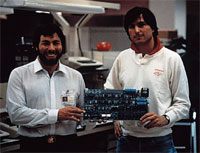
#2 – 1976- 77
Apple incorporates and releases the Apple II.
What’s almost as important as a company forming? Shipping their first product, of course. For Apple, that product was the Apple II. The Apple I was a home brew computer that Apple sold in very small quantity, but it was the Apple II that made the company what it would become. Between the brilliant design skills of Steve Wozniak, the evangelical and marketing genius of Steve Jobs, and the business acumen of Mike Markkula, Apple would go on to revolutionize the personal computing business.
For a while, Apple was the fastest growing business in American history. Their original business plan in 1977 called for the company to make $500 million dollars in ten years. They made that in five years. The Apple logo, now one of the most recognized brand logos in the world, was created in 1977, and while it no longer sports a rainbow color, the logo itself has remained unchanged.
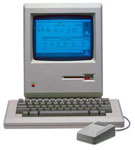
#3 – 1984
Apple introduces the Macintosh.
Without a doubt, the Macintosh changed the world. It’s hard to comprehend the cultural impact the original Macintosh has had on the world. I do believe that had Apple not created the Mac OS and its GUI (Graphic User Interface) someone else would have, I do have to wonder where computers would be today if it had been another company. Would IBM have done it? Microsoft? Sun? Sony? Xerox? Who can say. They probably wouldn’t have had the almost religious attention to detail that Apple did, so we would have ended up with something less than what we got. So it was Apple, and their implementation of the GUI in the form of the Mac OS has been, and continues to be, the yardstick all others are measured.
#4 – 1997
The Return of Steve Jobs
Apple was in trouble. They had lost a ton of money, made terrible business decisions, and saw their dominance in the personal computer world diminish. They were the very definition of a beleaguered company. Rumors named a different suitor to buy Apple every other day. Apple’s days were numbered. The sky was falling!
The story of how Steve Jobs returned to Apple has been told many times, and in much more depth than this article would permit. Many point out that some of the very business decisions that helped turn Apple around were made even before his return to the company, but it cannot be denied that it has been the leadership and business acumen that Jobs has displayed over the past eight years that has lead Apple to the plateau it holds today. Not afraid to take chances, and a high batting average on guessing what consumers want, Jobs is the Rock Star CEO.
How many awards have Apple products received under his reign? How many awards has Steve Jobs himself won? Too many to count.
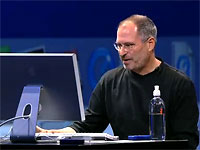
Who else but Steve Jobs could have taken a company as badly managed, hemorrhaging money everywhere, and turned it into the mecca of tech? How else could Apple have made the iPod a cultural phenomenon? How many other CEO’s host a yearly keynote address that is watched by millions of people over the Internet? How many times have other CEO’s appeared on the cover of Time Magazine, in effect turning one of the most popular magazines into a PR machine for your company and its products?
#5 – 1985
Steve Jobs leaves Apple.
Yes, Apple was a hugely popular and profitable company after Steve Jobs left the in 1985. For a time, that is. Still, for the culture and adventurous spirit that was Apple Computers, everything changed when Steve Jobs left. Without his visionary spirit, the company eventually lost more and more ground in the PC market. There was no one singular vision for the company, no one product that defined Apple. The different models of Macintosh computers exploded, and as the years went on, quality, innovation, and focus suffered, eventually bringing the company to the verge of disaster.
Perhaps this was for the best. Would Apple be where it is today had Steve Jobs won his boardroom battle with John Sculley? Was his time spent away from Apple a maturing process for Steve Jobs? Did the lessons learned at NeXT and Pixar, as well as his personal life, better prepare him for his eventual (and triumphant) return to Apple? I would hazard my own guess and say yes, leaving Apple was probably best for Steve Jobs at that time. Yes, he probably came back a different leader, more mature and focused, than he was twelve years prior. People change, although to what extent remains unknown for Steve Jobs. But to me, it goes without saying that this was a very pivotal time in this history of Apple.
(Editor’s note: David Every, before publishing this article, suggested the following, and we agree:) I would mention that the Mac was suffocating under Steve Jobs vision. He wouldn’t allow slots, expandability, and as soon as he left, the Mac II (OpenMac) was created. So at first, it was absolutely the right business decision that saved the Mac. But then, Apple was anarchy without focus or vision beyond offering more models.
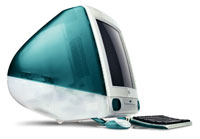
#6 – 1998
The iMac.
An all-in-one computer was not a new concept in 1998. Apple itself had been creating them since the first Macintosh way back in 1984. With the release of the iMac, however, computers became something more than a box you hid under your desk. It became not only a machine to do your work on, but a fashion statement as well.
The iMac challenged what a computer was supposed to be. It was never marketed as a work machine, or even as a powerful computer. It was all about the fun. Dancing, spinning, and lively music accompanied the computer on television commercials. This was a computer designed that women would call cute, unheard of in the computer industry at the time. In comparison to most other computers offered by Apple, it was relatively cheap. ($1,299)
There was some controversy as well. The introduction of two USB ports on the machine was a head scratcher for many, including myself, as there were no USB peripherals to plug in to it. Also the decision not to include a floppy drive seemed, to some, to be insane. But as usual, Apple changed the computer industry when they released the iMac. Soon, you would not find a computer that didn’t include USB, and more and more companies abandoned the use of the floppy disk.
The iMac was a cultural phenomenon. The following year, Apple released the revision C iMacs, this time in five different colors. Soon, everything from Toasters to spoons came in translucent plastic colors that obviously got their design cues from the iMac. You could not change the channel in the late 1990’s without seeing the colorful teardrop iMac on a host of television programs. (Americas Funniest Videos, for instance, had an entire wall of different color iMacs for one season.)
Without the success of the iMac in 1998, Apple would not be where they are today. We would have no iPods, iMovie, or all-on-one flat panel computers. The iMac has been a runaway success story for Apple. Today, the iMac is still the center of the Macintosh universe, as well as Apple’s Digital Hub.
Even the “i” in iMac became a cultural phenom, with the iPod, iLife, the iCEO, and so on.
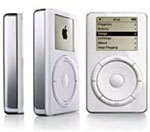
#7 – 2001
The iPod
There was a recent episode of the American version of “The Office” in which the boss spends more money on a Christmas gift than he is supposed to for an employee during their “Secret Santa” party. It’s a new video iPod. But when the boss himself receives his gift, he once again changes the rules, allowing the employees to trade their gift with their co-workers. And everybody wants the iPod.
Everybody wanting the iPod is more than a funny bit on a comedy show; it is a cold, hard fact of life in 2005.
First released in October 2001 at a special Apple event, the invite to selected members of the press promised a revolutionary new product, enticing them with “Hint: It’s not a Mac.” And the first, almost universal reaction, was “eh.”
Many didn’t know, nor could they predict, what was unleashed upon the world that day. The original iPod had a 5GB internal hard drive, and promised “1,000 songs in your pocket.” It was cute, sure, but also expensive at $399. It worked only with Macs and iTunes, allowing people to convert their CD collection to MP3 and to take your music with you. Coincidently, this was also a year after the fall of the original Napster, the free P2P file sharing application that allowed users to upload and download MP3 music files over the Internet. The popularity of Napster led to the MP3 file format becoming the dominant format for digital music, and with small digital music files, the world was hungry for small music playing devices that could hold a lot of music.
The iPod was not the first such product on the market. It was simply the first such product to get everything right. It was cute, which led to its trendy status. It had an innovative click-wheel interface than anyone could learn to operate in seconds. It allowed fast transfers (via FireWire) from a computer in seconds, rather than hours. And it sounded good.
As good as the iPod was, however, it would not reach cultural awareness status until Apple included USB 2.0 and compatibility with Windows. Third-party developers came out of the woodwork with peripherals for the iPod, from slipcases, portable speakers, FM Transmitters, and more. The iPod became such a huge hit for Apple, today many pundits argue that this is Apple’s future, not the Macintosh.
The iPod is staggering in its popularity. And as the popularity grows, Apple reaps the rewards in profitability and market dominance. The iPod has become more than a music playing devise, it has spawned new industries and creative outlets, such as Podcasting. Without a doubt, the iPod is the most important brand in the Apple stable of products, and that doesn’t look likely to change anytime soon.
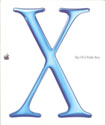
#8 – 2000
Mac OS X
The future was seen by the general public for the first time at Macworld Expo 2000, when Steve Jobs unveiled Mac OS X. Apple had originally tried to create their next generation operating system years before, then called Mac OS 8, or internally as Copland. That project was doomed for failure for numerous reasons (which I hope David Every will write about someday soon!) and in 1996-97, Apple management went about looking for a modern operating system Apple could purchase and turn into the next version of the Mac OS. At the time, it looked to all the world as if Apple would purchase Be Inc., but the asking price was simply too high for the level of work it would take to get the Be OS up and running to Apple standards. (Much work was left undone on the Be OS and BeOS was totally new, something completely different, and pretty much completely incompatible to everything else on the planet. In a move that surprised many, Apple went and purchased NeXT instead, and used the NeXT Step operating system as the foundation for Mac OS X. Many of the core technologies found within the NeXT OS can be found in Mac OS X, and many like UNIX, PDF (Display PostScript), OpenGL, etc., were far more “compatible” with the world at large.
On September 13th, 2000, the first beta of Mac OS X was released to the general public. (Cost: $29.95) I was one of the beta testers for the new system, and was duly impressed with much of what I saw. While the beta was not ready for prime time yet, (and some would argue that it wasn’t until Mac OS 10.3 that it finally was) it showed off the underlining technologies that Mac users had been waiting years for.
Some of the new features were protected memory, the Aqua interface, the Dock, and Unix at the core of it all. While some elements of the older Mac OS were still present in appearance, the Mac OS X was built from the ground up as a new OS, not building upon the decades-old OS.

#9 – 1994
PowerPC
Much like the latest announced move to the Intel processors, the first processor move Apple made from the 68K to the PowerPC chips was not without controversy and problems. But there were also similarities as well.
Apple wanted faster and more powerful computers, and to get to that point, they formed an alliance with both Motorola and IBM. (Called AIM, I will let you figure out what that acronym stands for) Developed jointly, the new processor family was much more powerful and robust than the 68K (68000) processor. The PowerPC was so powerful, in fact, that it could actually run 68K processor code and its own native PowerPC code. This meant that older applications would run just fine on the new Power Mac systems. This was critical. If you purchased a new Power Mac, and none of your existing applications were able to run, chances were fewer consumers would opt for the new machines. No one wanted to invest in all new software, and no one wanted to see their current software investment become obsolete. This is similar to what Apple has created in Rosetta for the move to Intel, in that Rosetta will run (in emulation) PowerPC code, so that your current copy of Adobe Photoshop will run just fine (albeit more slowly, depending upon the speed and power of the Intel chip) on the next generation of Power Macs.
What made these chips so powerful? They ran 32-bit code (the 68K was 16-bit, although it did use 32-bit address space), and were scalable up to much higher MHz (and later GHz) ratings. It could access much more RAM as well. Not being a processor expert, let’s just say that for all practical purposes, the PowerPC chip was much more powerful than the 68K chips. The RISC design of the PowerPC meant that it cost less in transistors, time and money to create each subsequent release — which meant faster and cheaper processors. Long term, it bought time against the Intel (x86) juggernaught. (Is this true of the PowerPC vs. Intel chips? Only time will tell)
The move to PowerPC has lasted twelve years (and still has a few to go), longer than 68K generation did. (1984 – 1994, at least in the Macintosh line) The first PowerPC Macs from Apple, the 6100, 7100, and 8100, were based on the PowerPC 601 chip running 60-80MHz. The top of the line machine, the PowerMac 8100, cost $4,200. Apple would release many machines based on the PowerPC standard, including the 64-bit G5 processor. But the initial move to the PowerPC was huge for Apple, and a risky one at that. Would the consumer adopt the new systems? Would software vendors make the switch? To create a next-generation operating system, Apple knew it needed a faster and more modern microprocessor, and that they first needed the software vendors to get behind the new processors before they could even contemplate a redesigned OS.
System software and processors go hand-in-hand on computers. You cannot run a PowerPC native OS (such as Mac OS 9) on a non-PowerPC machine. The same is true in reverse, without emulation. So to look where Apple is going with the switch to Intel, it is educational to look to the past when Apple first made this kind of switch.
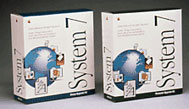
#10 – 1991
Mac OS 7
Many of the later operating system releases by Apple had huge impact upon how Mac users used their computer (and influenced all personal computers), but at the time, none more so than Mac OS 7. Many new features made their first appearance in Mac OS 7. It was the first major overhaul to the Mac OS, much like OS X was. Of course, OS X was a completely new OS, while System 7 was not. Still, the significance of System 7 should not be downplayed. Simply taking a look at the new features first introduced with the system should shed some light on the importance of this OS.
File Sharing. It’s easy to take this for granted today, but before Mac OS 7, there was no one easy way to share files and folders from one Mac to another. File Sharing under Mac OS 7 made it easy to connect to an Apple Talk network and share files and folders. File Sharing on Mac OS 7 made the concept of a home network seem not only (somewhat) easy for the first time, but also relatively cheap.
System Extensions. Sure, there were system extensions around before OS 7, but now users could actually disable them at start-up by holding down the shift key. System Extensions were, more often than not, the reason for many system crashes, and an easy way of disabling them at start-up was a huge timesaver for Mac users. Just installed software, and all of a sudden your system started to crash? Chances were, that program had also installed a system extension (or control panel) and removing that extension was an easy fix.
The System Extensions were also easy to find for the first time. Inside the system folder was another folder called (amazingly) System Extensions. Mac OS 7.5 introduced the Extension Manager, a control panel that could be used to turn on/off system extensions. So, for instance, if you have two System Extensions that conflicted with one another, but you needed both from time to time, a user could simply turn one off and the other on, reboot the computer, and be on their merry way.
(Mac OS X does not use System Extensions)
Control Panels. Before Mac OS 7, there was just one Control Panel. OS 7 made it so that there could be multiple control panels, allowing easy expansion of the capabilities of the OS. Like System Extensions, Control Panels were both a curse and a blessing. They, too, were the cause of many system instabilities, and like System Extensions, you could disable them at start-up.
There was no user interactivity with System Extensions. Those were just files you placed in your system that did their thing, whereas Control Panels gave the user some level of actual control over the behavior the Control Panel could perform. While Mac OS X also has a control panel, and many of the functions are the same (setting time and date, changing background pictures, turning on/off file sharing, etc.) they are not the same thing.
Apple Script. Apple Script had its first appearance with System 7. Apple Script is still a default install under OS X. How many other technologies did Apple introduce back in 1992 are still around in everyday use? That alone should tell you the importance of Apple Script, a relatively simply but powerful programming language that anyone can master with but a little time and practice.
The Hard Drive. Mac OS 7 was the first Mac OS that required a Hard Drive for installation. Before, you could have your OS on a floppy drive and boot from that, but Mac OS 7 needed a hard drive to operate. (Users could have a stripped down OS 7 boot-up floppy, but it was for emergency boot-ups, not everyday work)
Window Disks. Finally, Mac users were able to read MS-DOS floppy disks. This spurred the compatibility of file formats between a Mac and Windows applications. With OS 7, when you inserted a PC floppy disk, the disk would mount on the desktop, and a user could copy a file to and from the disk. Before Mac OS 7, when you inserted a PC disk, the Mac was unable to read the disk and wanted to reformat it as a Mac disk. (Thus erasing the data on said disk)
QuickTime. While QuickTime did not appear with the first release of Mac OS 7, it did make its debut with Mac OS 7.1. QuickTime was actually shown to developers before Mac OS 7 was even released, and the essence of QuickTime is the same today as it was then. True, today’s QuickTime is much more powerful and feature-rich than that first version, QuickTime is another technology which can trace its roots back to Mac OS 7.
Cooperative Multitasking. Hey, the ability to have one application running more than once was finally not an option, but a built-in reality under Mac OS 7.
EMail was integrated into the Operating System with that catchy technology, AOCE. It was the first finder to really be able to find things (the precursor to Sherlock). Windows Compatibility (FileExchange/Translation built in). Better Graphics engine (with QDGX). Apple created the ability to embed objects/documents in others (Publish and Subscribe), which Microsoft borrowed and expanded (and removed all security) until it became ActiveX. And much more.
11 – 2006
Intel?
It’s too soon to tell the impact the move to Intel will have on the Macintosh platform. Yes, it will have far reaching effects on the Macintosh, but what those effects will be is still pure speculation. Changing the type of processors your computers run on is a major change and not without risks. One can look back on the PowerPC chance for some clue as to what to expect, but today’s computer age is vastly different from the one in 1994.
It seems that many things are conspiring (by plan) to work in the Intel transitions favor for Apple. The iPod effect is selling more Macs. The market has matured to where people are more platform agnostic. Apple has added Office/Windows compatibility to OSX and their iApps. Windows and its lack of security are suffocating the platform, and the slow and painful Vista transition coming. Apple’s dominating the Media segment. Apple’s recognized leadership in design/quality. The speed bump and the cost decreases of the Intel transition. And now some degree of PC/Windows compatibility right at the hardware level? These should be the catalysts to help radically increase sales and marketshare.
Special thanks to David Every for some additions (That last paragraph for one) and alterations to this article, making it even better than I could alone. Russ Walkowich, as always, took my crude writing and turned it into something remotely readable. Thanks, David and Russ! You guys are the best! -Tim
Agree? Disagree? Post your comments below

Leave a Reply
You must be logged in to post a comment.